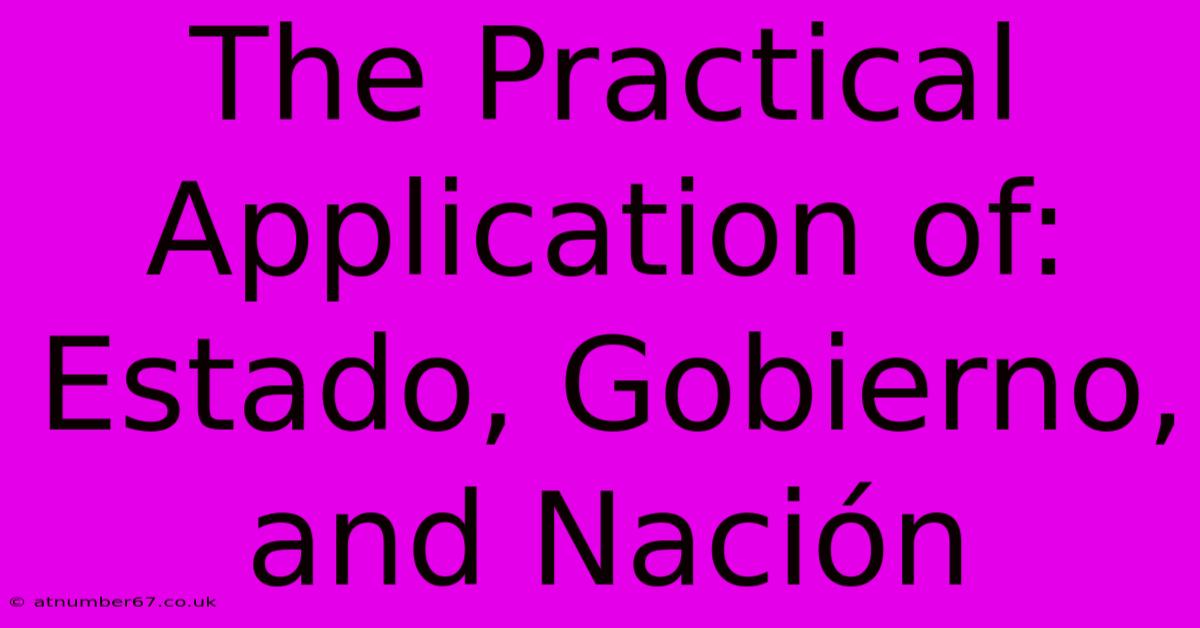The Practical Application Of: Estado, Gobierno, And Nación

Table of Contents
The Practical Application of: Estado, Gobierno, and Nación
Understanding the nuances between Estado, Gobierno, and Nación is crucial for comprehending political structures, particularly in Spanish-speaking contexts. While often used interchangeably in casual conversation, these terms represent distinct yet interconnected concepts with significant practical applications. This article will delve into each concept individually and then explore their interplay in real-world scenarios.
What is Estado? (The State)
Estado, in its political context, refers to the permanent structure of power within a defined territory. It encompasses the entire apparatus of government, including its institutions, laws, and bureaucracy. Think of it as the machinery of governance. The Estado is characterized by:
- Sovereignty: The Estado holds supreme authority within its borders.
- Territory: It governs a specific geographic area.
- Population: It exercises authority over a defined population.
- Legitimacy: Its authority is generally accepted, though the basis of this legitimacy may vary.
Example: The Estado of Mexico includes its constitution, its legislative, executive, and judicial branches, its various levels of government (federal, state, municipal), and its administrative bodies. The Estado itself endures even through changes in Gobierno.
What is Gobierno? (The Government)
Gobierno refers to the group of people currently exercising political power within the Estado. It’s the acting administration. This is the temporary aspect of governance. It's composed of individuals holding specific positions of authority, responsible for implementing the policies and laws established by the Estado. The Gobierno changes through elections or other means, but the Estado remains.
- Specific Personnel: The Gobierno is made up of identifiable individuals, such as the president, cabinet members, and other officials.
- Temporary Nature: Its tenure is limited by term limits or other factors.
- Policy Implementation: Its primary function is the execution of government policies and laws.
Example: The current Gobierno of Spain under Pedro Sánchez is distinct from previous Gobiernos. The Gobierno changes, but the Estado of Spain persists.
What is Nación? (The Nation)
Nación refers to a community of people bound together by shared characteristics, such as language, culture, history, traditions, or ancestry. It's about a sense of collective identity, often possessing aspirations for self-determination. Unlike the Estado and Gobierno, the Nación isn't inherently tied to a specific territory or formal political structure.
- Shared Identity: Members of a Nación share a sense of belonging and common identity.
- Cultural Unity: Often characterized by a common language, culture, and history.
- Self-Determination: Nations often strive for autonomy or independence.
Example: The Kurdish Nación spans across multiple states, lacking a single unified Estado. The Catalan Nación within Spain strives for greater autonomy within the existing Spanish Estado.
The Interplay of Estado, Gobierno, and Nación
The relationship between these three concepts is complex and often dynamic. A nation may have its own Estado (like France), or it may be spread across multiple states (like the Kurds). A state may contain multiple nations (like Canada). The Gobierno, meanwhile, is the temporary administration working within the established framework of the Estado.
Practical Application Examples:
- Political Stability: A strong Estado with clear rules and institutions contributes to political stability, regardless of changes in Gobierno.
- National Unity: A Gobierno that respects the cultural diversity of the Nación fosters national unity and stability.
- Conflict Resolution: Understanding the distinctions between Estado, Gobierno, and Nación can help clarify the root causes of political conflicts and aid in finding effective solutions.
- Constitutionalism: The constitution of a state helps define the relationship between the Estado, the Gobierno, and the aspirations of the Nación.
Understanding the differences and interrelationships between Estado, Gobierno, and Nación provides a more nuanced comprehension of political systems, particularly those that don't perfectly align with the nation-state model. This understanding is vital for political analysis, international relations, and civic engagement.

Thank you for visiting our website wich cover about The Practical Application Of: Estado, Gobierno, And Nación. We hope the information provided has been useful to you. Feel free to contact us if you have any questions or need further assistance. See you next time and dont miss to bookmark.
Featured Posts
-
Dragon Age Veilguard Character Creation Step By Step
Apr 06, 2025
-
Stuart Pearce Football Legend And Financial Powerhouse
Apr 06, 2025
-
Sung Jin Woo Sons Inner Conflict
Apr 06, 2025
-
Emmy Rossums Daughter A Mothers Pride
Apr 06, 2025
-
Pamela Anderson Age A Look At Her Personal Life
Apr 06, 2025
